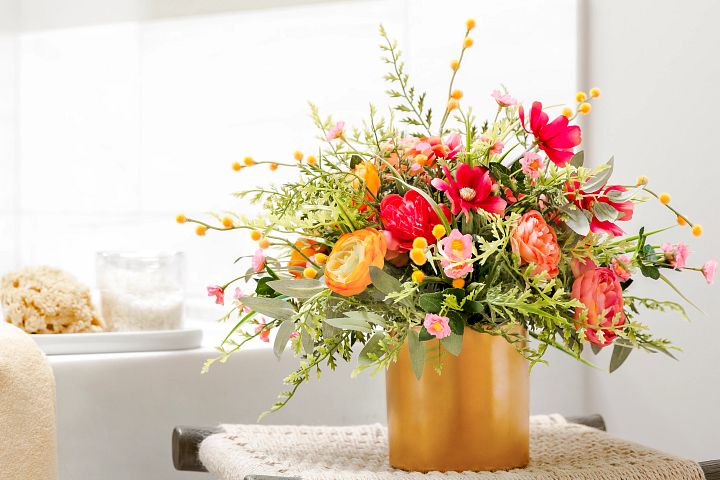Flowers have been an essential part of human culture and decor for centuries. Their vibrant colors, unique shapes, and captivating fragrances have made them symbols of emotions, celebrations, and traditions. From ancient rituals to modern interior design, flowers have carried meanings that transcend generations. This article explores the history and symbolism of some of the most popular flowers used in decor, shedding light on their enduring appeal.
1. Roses: The Eternal Symbol of Love
Roses have been synonymous with love and passion for centuries. Their history dates back to ancient civilizations such as the Greeks and Romans, where they were associated with deities like Aphrodite and Venus, the goddesses of love.
Historical Significance:
- In the Roman Empire, roses were often used in festivals and celebrations.
- During the Middle Ages, roses symbolized secrecy and were used to decorate confessionals.
- In Victorian England, roses became central to the language of flowers, where different colors conveyed specific messages.
Symbolism:
- Red Roses: Love and passion.
- White Roses: Purity and innocence.
- Yellow Roses: Friendship and joy.
- Pink Roses: Gratitude and admiration.
Roses remain a timeless choice for decor, from romantic settings to elegant centerpieces.
2. Lilies: Purity and Renewal
Lilies have long been associated with purity, renewal, and spirituality. Their graceful form and delicate fragrance make them a popular choice for both celebratory and solemn occasions.
Historical Significance:
- In ancient Egypt, lilies symbolized fertility and were depicted in art and artifacts.
- The Greeks and Romans associated lilies with motherhood and rebirth.
- In Christian traditions, lilies are linked to the Virgin Mary and are often used in religious ceremonies.
Symbolism:
- White Lilies: Purity and virtue.
- Orange Lilies: Confidence and energy.
- Yellow Lilies: Gratitude and cheerfulness.
Lilies are frequently used in wedding bouquets, religious ceremonies, and home decor for their serene beauty.
3. Sunflowers: Happiness and Vitality
Sunflowers, with their bright yellow petals and large, cheerful faces, are a universal symbol of happiness and vitality. Their history is deeply rooted in Native American cultures, where they were revered for their utility and beauty.
Historical Significance:
- Native Americans used sunflowers for food, oil, and dyes.
- During the Renaissance, sunflowers became a symbol of the sun and divine light in European art.
- Van Gogh’s famous sunflower paintings elevated their status in modern art.
Symbolism:
- Happiness: Bright yellow hues evoke joy and optimism.
- Loyalty: Sunflowers’ ability to face the sun symbolizes steadfastness.
- Abundance: Their large, seed-filled centers represent plenty.
Sunflowers are often used in rustic and farmhouse decor, adding warmth and cheer to spaces.
4. Orchids: Elegance and Exotic Beauty
Orchids are admired for their exotic appearance and sophisticated charm. Their delicate structure and diverse range of colors make them a symbol of luxury and refinement.
Historical Significance:
- In ancient China, orchids represented integrity and elegance.
- The Victorians collected orchids as a status symbol, reflecting wealth and prestige.
- Indigenous cultures in Central and South America used orchids in traditional medicines and rituals.
Symbolism:
- Pink Orchids: Grace and femininity.
- White Orchids: Purity and elegance.
- Purple Orchids: Royalty and admiration.
Orchids are ideal for modern and minimalist decor, bringing a touch of sophistication to any setting.
5. Daisies: Innocence and Simplicity
Daisies are simple yet charming flowers that symbolize innocence, purity, and new beginnings. Their association with childhood and purity makes them a popular choice for cheerful and casual decor.
Historical Significance:
- In Celtic mythology, daisies were believed to be the spirits of children who passed away, bringing comfort to grieving parents.
- The Victorians included daisies in the language of flowers, representing loyalty and innocence.
- In Norse mythology, daisies were sacred to Freya, the goddess of love and fertility.
Symbolism:
- White Daisies: Innocence and purity.
- Yellow Daisies: Cheerfulness and optimism.
- Gerbera Daisies: Joy and celebration.
Daisies are often used in spring and summer decor for their fresh and youthful appeal.
6. Tulips: Love and Prosperity
Tulips are known for their simple elegance and vibrant colors. Originating in Central Asia, they became a symbol of wealth and prosperity during the 17th-century “Tulip Mania” in the Netherlands.
Historical Significance:
- Tulips were cultivated in Persia and featured in Islamic art and poetry.
- During the Dutch Golden Age, tulips were highly valued and traded as luxury items.
- Today, tulips are synonymous with spring and renewal.
Symbolism:
- Red Tulips: Deep love.
- Yellow Tulips: Cheerfulness.
- Purple Tulips: Royalty.
- White Tulips: Forgiveness.
Tulips are a versatile choice for home decor, event arrangements, and seasonal displays.
7. Carnations: Affection and Remembrance
Carnations are long-lasting flowers that carry rich symbolism. Their ruffled petals and wide range of colors make them a favorite for various occasions.
Historical Significance:
- In ancient Rome, carnations were used in ceremonial crowns.
- During the Renaissance, they symbolized marriage and love in art.
- Modern Mother’s Day celebrations often feature carnations as a tribute to maternal love.
Symbolism:
- Red Carnations: Love and admiration.
- Pink Carnations: Gratitude and affection.
- White Carnations: Purity and luck.
- Yellow Carnations: Friendship and joy.
Carnations are a practical and meaningful option for everyday arrangements and special events.
8. Lavender: Calm and Healing
Lavender is cherished for its calming fragrance and delicate purple blooms. Its history is intertwined with wellness and relaxation practices.
Historical Significance:
- In ancient Egypt, lavender was used in mummification and perfumes.
- The Romans used lavender in baths and as an antiseptic.
- During the Middle Ages, lavender was believed to ward off evil spirits.
Symbolism:
- Calmness: Associated with relaxation and peace.
- Healing: Linked to wellness and recovery.
- Purity: Represents cleanliness and clarity.
Lavender is often used in rustic and cottage-style decor for its soothing presence.
Final Thoughts
Flowers have played a significant role in human history, offering more than just aesthetic appeal. Their symbolism and cultural significance continue to shape how we use them in decor today. Whether you choose roses for love, sunflowers for happiness, or orchids for elegance, each flower carries a unique story and meaning.
By understanding their history and symbolism, you can create arrangements that not only beautify spaces but also convey heartfelt messages.


